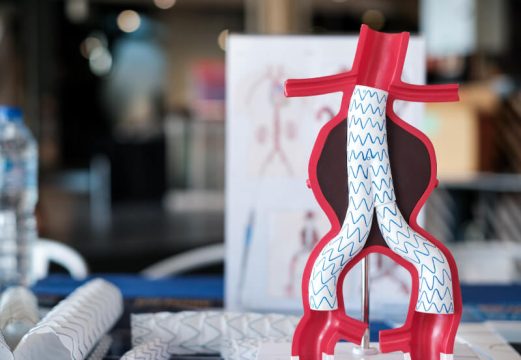New unibody endologix endografts for the endovascular repair of abdominal aortic aneurysm 3-4-year safety followup
At present, we have seen endovascular intervention of abdominal aortic aneurysm (EVAR) increase over surgical repair. However, the procedure is not free from complications, endoleak being the most frequent. Indeed, according to different series, it has a 20-25% incidence in AAA.

Most of these devices employ stents, barbs or hooks for active fixation in their aortic trajectory. Unlike these, the Endologix device presents a specific characteristic: passive anatomical fixation for aortic bifurcation deployment, preventing distal migration of the main component, followed by proximal anchoring.
These characteristics might be beneficial in specific situations such as narrow access, conical reversed neck and very narrow distal aorta. Type III endoleak has been seen at followup, both early and late, as a consequence of endograft design (fabric attached to device top and bottom).
This is why the SAFE-AAA was designed (together with the FDA) to assess the safety of unibody endograft AFX and AFX2 (Endologix). Primary end point was the composite of aneurysm rupture, aortic reintervention or all-cause mortality following stent deployment. Secondary end point were separate primary end point components, perioperative morbimortality and surgical complications.
Read also: When Is It Best to Fracture a Bioprosthesis in TAVR?
87163 Medicare patients receiving EVAR (both unibody [Endologix AFX] and non-unibody stent grafts) were looked at, 13.7% (11903) receiving Unibody stent grafts. Mean age was 77, 21.1% were women, 74.9% presented ischemic cardiomyopathy, 35.8% diabetes and 90.8% hypertension.
Patients were followed up for mean 3.3 years, 8.4 years maximum. Long term followup showed a primary end point incidence of 73.9% with the unibody device and 65% with non-unibody devices. Primary end point hazard ratio was 1.20 (CI 95% 1.17-1.24).
The following sensitivity analysis showed 19% increase in events, without reaching non-inferiority, with a number needed to harm of 12. This increase in events was driven by all-cause mortality, conversion to open surgery, endograft extension and late sack rupture.
Read also: Amyloidosis and TAVR: Does this Disease Have an Impact?
When looking at secondary events, there was lower risk of myocardial infarction, pneumonia and deep vein thrombosis at 30 days in patients receiving the unibody device.
Conclusions
The SAFE-AAA provides relevant information on the safety of Endologix unibody device, which have failed to reach non-inferiority when compared against non-unibody devices. This calls for the use reassessment of these devices, especially at long term.

Dr. Omar Tupayachi.
Member of the Editorial Board of SOLACI.org.
Original Title: Comparison of Unibody and Non-Unibody Endografts for Abdominal Aortic Aneurysm Repair in Medicare Beneficiaries: The SAFE-AAA Study.
Reference: Secemsky EA, Song Y, Sun T, Johnson CG, Gatski M, Wang L, Farb A, Lee RE, Shaw A, Xu J, Yeh RW. Comparison of Unibody and Non-Unibody Endografts for Abdominal Aortic Aneurysm Repair in Medicare Beneficiaries: The SAFE-AAA Study. Circulation. 2023 Mar 3. doi: 10.1161/CIRCULATIONAHA.122.062123. Epub ahead of print. PMID: 36866664.
Subscribe to our weekly newsletter
Get the latest scientific articles on interventional cardiology





